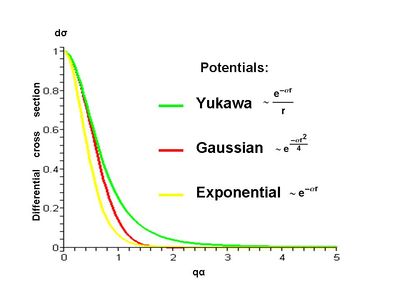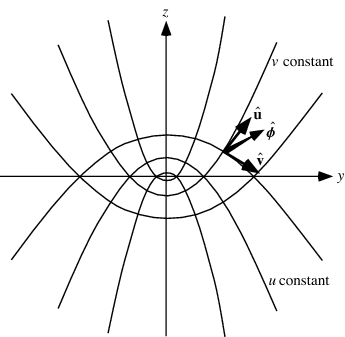Coulomb Potential Scattering
We now consider the scattering of an electron from the Coulomb potential. This problem is important because it is relevant to the famous scattering experiment by Rutherford that showed that the atomic nucleus only makes up a very small fraction of the total size of an atom. We will first use the Born approximation to find the cross section for a Yukawa potential,
Failed to parse (SVG (MathML can be enabled via browser plugin): Invalid response ("Math extension cannot connect to Restbase.") from server "https://wikimedia.org/api/rest_v1/":): {\displaystyle V(r)=V_0\frac{e^{-\alpha r}}{r},}
which reduces to the Coulomb potential when Failed to parse (SVG (MathML can be enabled via browser plugin): Invalid response ("Math extension cannot connect to Restbase.") from server "https://wikimedia.org/api/rest_v1/":): {\displaystyle \alpha\to 0.} We will then find the exact cross section for the Coulomb potential, starting with the Schrödinger equation.
Scattering From a Yukawa Potential in the Born Approximation

Here we compare the differential cross sections for the Yukawa, Gaussian and exponential potential. We can see that for small Failed to parse (SVG (MathML can be enabled via browser plugin): Invalid response ("Math extension cannot connect to Restbase.") from server "https://wikimedia.org/api/rest_v1/":): {\displaystyle q\alpha \!} all differential cross sections are similar. The differential cross section of the exponential potential decreases faster than the others and that of the Yukawa potential decreases more slowly than the others.
As alluded to earlier, let us first consider the Yukawa potential,
Failed to parse (SVG (MathML can be enabled via browser plugin): Invalid response ("Math extension cannot connect to Restbase.") from server "https://wikimedia.org/api/rest_v1/":): {\displaystyle V(r)=V_0\frac{e^{-\alpha r}}{r}.}
Within the Born approximation, the scattering amplitude is
Failed to parse (SVG (MathML can be enabled via browser plugin): Invalid response ("Math extension cannot connect to Restbase.") from server "https://wikimedia.org/api/rest_v1/":): {\displaystyle \begin{align} f(\theta) &= -\frac{m}{2\pi\hbar^2}2\pi\int_0^\infty dr'\,r'^2 \frac{e^{-i|\mathbf{k}'-\mathbf{k}|r'}-e^{i|\mathbf{k}-\mathbf{k}'|r'}}{-i|\mathbf{k}'-\mathbf{k}|r'}\frac{V_0e^{-\alpha r'}}{r'} \\ &= -\frac{2mV_0}{\hbar^2}\int_0^\infty dr' r'^2 \frac{\sin\left(|\mathbf{k}'-\mathbf{k}|r'\right)}{|\mathbf{k}'-\mathbf{k}|r'}\frac{e^{-\alpha r'}}{r'} \\ &= -\frac{2mV_0}{\hbar^2}\frac{1}{\left(\left|\mathbf{k}'-\mathbf{k}\right|\right)^2+\alpha^2} \end{align} }
For the elastic scattering Failed to parse (SVG (MathML can be enabled via browser plugin): Invalid response ("Math extension cannot connect to Restbase.") from server "https://wikimedia.org/api/rest_v1/":): {\displaystyle \left| \mathbf{k} \right| = \left| \mathbf{k'} \right| = k \!} . Therefore,
Failed to parse (SVG (MathML can be enabled via browser plugin): Invalid response ("Math extension cannot connect to Restbase.") from server "https://wikimedia.org/api/rest_v1/":): {\displaystyle (\left|\mathbf{k}'-\mathbf{k}\right|)^2 = 2k\sin\frac{\theta}{2} }
and thus
Failed to parse (SVG (MathML can be enabled via browser plugin): Invalid response ("Math extension cannot connect to Restbase.") from server "https://wikimedia.org/api/rest_v1/":): {\displaystyle f = -\frac{2mV_0}{\hbar^2}\frac{1}{4k^2\sin^2\frac{\theta}{2}+\alpha^2}. }
The differential cross section is then
Failed to parse (SVG (MathML can be enabled via browser plugin): Invalid response ("Math extension cannot connect to Restbase.") from server "https://wikimedia.org/api/rest_v1/":): {\displaystyle \frac{d\sigma}{d\Omega}= \left( \frac{2mV_0}{\hbar^2} \right) ^2 \left( \frac{1}{4k^2\sin^2\frac{\theta}{2}+\alpha^2}\right)^2.}
Exact Coulomb Scattering Cross Section

Failed to parse (SVG (MathML can be enabled via browser plugin): Invalid response ("Math extension cannot connect to Restbase.") from server "https://wikimedia.org/api/rest_v1/":): {\displaystyle \phi\!} represents rotation about the z-axis, Failed to parse (SVG (MathML can be enabled via browser plugin): Invalid response ("Math extension cannot connect to Restbase.") from server "https://wikimedia.org/api/rest_v1/":): {\displaystyle \xi\!} represents the parabolas with their vertices at a minimum, and Failed to parse (SVG (MathML can be enabled via browser plugin): Invalid response ("Math extension cannot connect to Restbase.") from server "https://wikimedia.org/api/rest_v1/":): {\displaystyle \eta\!} represents parabolas with their vertices at a maximum.
When we are considering scattering due to the Coulomb potential, we can not neglect the effect of this potential at large distances because it is only a Failed to parse (SVG (MathML can be enabled via browser plugin): Invalid response ("Math extension cannot connect to Restbase.") from server "https://wikimedia.org/api/rest_v1/":): {\displaystyle \frac{1}{r}} potential.
We will work in parabolic coordinates, which are related to Cartesian coordinates by
Failed to parse (SVG (MathML can be enabled via browser plugin): Invalid response ("Math extension cannot connect to Restbase.") from server "https://wikimedia.org/api/rest_v1/":): {\displaystyle \xi=\sqrt{x^2+y^2+z^2}-z}
Failed to parse (SVG (MathML can be enabled via browser plugin): Invalid response ("Math extension cannot connect to Restbase.") from server "https://wikimedia.org/api/rest_v1/":): {\displaystyle \eta=\sqrt{x^2+y^2+z^2}+z}
Failed to parse (SVG (MathML can be enabled via browser plugin): Invalid response ("Math extension cannot connect to Restbase.") from server "https://wikimedia.org/api/rest_v1/":): {\displaystyle \phi=\tan^{-1}\left (\frac{y}{x}\right )}
The Schrödinger equation in parabolic coordinates is
Failed to parse (SVG (MathML can be enabled via browser plugin): Invalid response ("Math extension cannot connect to Restbase.") from server "https://wikimedia.org/api/rest_v1/":): {\displaystyle \left[ - \frac{\hbar^2}{2\mu}\frac{4}{\xi+\eta} \left( \frac{\partial}{\partial \xi}\xi\frac{\partial}{\partial \xi}+\frac{\partial}{\partial \eta}\eta\frac{\partial}{\partial \eta}+\frac{\xi+\eta}{4\xi\eta}\frac{\partial^2}{\partial \phi^2} \right) -\frac{2Ze^2}{\xi+\eta} \right] \psi=\frac{\hbar^2k^2}{2\mu}\psi.}
Recall that, for a spherically symmetric potential, the scattering amplitude is a function of Failed to parse (SVG (MathML can be enabled via browser plugin): Invalid response ("Math extension cannot connect to Restbase.") from server "https://wikimedia.org/api/rest_v1/":): {\displaystyle \theta\!} only; therefore, we will seek solutions that are independent of Failed to parse (SVG (MathML can be enabled via browser plugin): Invalid response ("Math extension cannot connect to Restbase.") from server "https://wikimedia.org/api/rest_v1/":): {\displaystyle \phi.\!}
We will look for solution of the form,
Failed to parse (SVG (MathML can be enabled via browser plugin): Invalid response ("Math extension cannot connect to Restbase.") from server "https://wikimedia.org/api/rest_v1/":): {\displaystyle \psi(\xi,\eta,\phi)=e^{\frac{i}{2}k(\eta-\xi)}\Phi(\xi)=e^{ikz}\Phi(r-z).}
The Schrödinger equation then becomes
Failed to parse (SVG (MathML can be enabled via browser plugin): Invalid response ("Math extension cannot connect to Restbase.") from server "https://wikimedia.org/api/rest_v1/":): {\displaystyle \left[ \xi\frac{\partial^2}{\partial \xi^2}+(1-ik\xi)\frac{\partial}{\partial \xi}+\frac{Ze^2\mu}{k\hbar^2}k \right]\Phi(\xi)=0.}
We now assume a series solution,
Failed to parse (SVG (MathML can be enabled via browser plugin): Invalid response ("Math extension cannot connect to Restbase.") from server "https://wikimedia.org/api/rest_v1/":): {\displaystyle \Phi(\xi)=\sum_{n=0}^\infty a_n \xi^n.}
The recursion relation for the coefficients is then
Failed to parse (SVG (MathML can be enabled via browser plugin): Invalid response ("Math extension cannot connect to Restbase.") from server "https://wikimedia.org/api/rest_v1/":): {\displaystyle \frac{a_{n+1}}{a_{n}}=\frac{in-\lambda}{(n+1)^2}k=\frac{n+i\lambda}{(n+1)^2}ik,}
where
Failed to parse (SVG (MathML can be enabled via browser plugin): Invalid response ("Math extension cannot connect to Restbase.") from server "https://wikimedia.org/api/rest_v1/":): {\displaystyle \lambda=\frac{Ze^2\mu}{k\hbar^2}.}
Recall that the confluent hypergeometric function Failed to parse (SVG (MathML can be enabled via browser plugin): Invalid response ("Math extension cannot connect to Restbase.") from server "https://wikimedia.org/api/rest_v1/":): {\displaystyle {}_1F_1} is given by
Failed to parse (SVG (MathML can be enabled via browser plugin): Invalid response ("Math extension cannot connect to Restbase.") from server "https://wikimedia.org/api/rest_v1/":): {\displaystyle _1F_1(a,c,z)=1+\frac{a}{c}z+\frac{a(a+1)}{c(c+1)}\frac{z^2}{2!}+\dots+\frac{a(a+1)\dots(a+n-1)}{c(c+1)\dots(c+n-1)}\frac{z^n}{n!}+\dots}
The recursion formula for its coefficients is
Failed to parse (SVG (MathML can be enabled via browser plugin): Invalid response ("Math extension cannot connect to Restbase.") from server "https://wikimedia.org/api/rest_v1/":): {\displaystyle \dfrac{\alpha_{n+1}}{\alpha_n}= \left( \dfrac{a+n}{c+n} \right) \dfrac{1}{n+1}.}
Comparing this to what we obtained earlier, we find that Failed to parse (SVG (MathML can be enabled via browser plugin): Invalid response ("Math extension cannot connect to Restbase.") from server "https://wikimedia.org/api/rest_v1/":): {\displaystyle \Phi(\xi)} is
Failed to parse (SVG (MathML can be enabled via browser plugin): Invalid response ("Math extension cannot connect to Restbase.") from server "https://wikimedia.org/api/rest_v1/":): {\displaystyle \Phi(\xi)=A{}_1F_1(i\lambda,1,ik\xi),\!}
where Failed to parse (SVG (MathML can be enabled via browser plugin): Invalid response ("Math extension cannot connect to Restbase.") from server "https://wikimedia.org/api/rest_v1/":): {\displaystyle A\!} is a c-number.
The full wave function is thus
Failed to parse (SVG (MathML can be enabled via browser plugin): Invalid response ("Math extension cannot connect to Restbase.") from server "https://wikimedia.org/api/rest_v1/":): {\displaystyle \psi(r,z)=A{}_1F_1(i\lambda,1,ik(r-z))e^{ikz}.\!}
In the limit, Failed to parse (SVG (MathML can be enabled via browser plugin): Invalid response ("Math extension cannot connect to Restbase.") from server "https://wikimedia.org/api/rest_v1/":): {\displaystyle z\to\infty,} the confluent hypergeometric function is approximately
Failed to parse (SVG (MathML can be enabled via browser plugin): Invalid response ("Math extension cannot connect to Restbase.") from server "https://wikimedia.org/api/rest_v1/":): {\displaystyle {}_1F_1(a,c,z)=\frac{\Gamma(c)(-z)^a}{\Gamma(c-a)} \left[ 1-\frac{a(a-c+1)}{z} \right] +\frac{\Gamma(c)}{\Gamma(a)}e^zz^{a-c}.}
We may use this to rewrite Failed to parse (SVG (MathML can be enabled via browser plugin): Invalid response ("Math extension cannot connect to Restbase.") from server "https://wikimedia.org/api/rest_v1/":): {\displaystyle \Phi\!} in the limit of large Failed to parse (SVG (MathML can be enabled via browser plugin): Invalid response ("Math extension cannot connect to Restbase.") from server "https://wikimedia.org/api/rest_v1/":): {\displaystyle \xi} as
Failed to parse (SVG (MathML can be enabled via browser plugin): Invalid response ("Math extension cannot connect to Restbase.") from server "https://wikimedia.org/api/rest_v1/":): {\displaystyle \Phi(\xi)=Ae^{\frac{-\pi}{2}\lambda} \left[ \frac{e^{i\lambda \ln(k\xi)}}{\Gamma(1-i\lambda)} \left( 1-\frac{\lambda^2}{ik\xi} \right) +\frac{i\lambda}{ik\xi}\frac{e^{ik\xi+i\lambda \ln(k\xi)}}{\Gamma(1+i\lambda)} \right].}
In the same limit, the full wave function Failed to parse (SVG (MathML can be enabled via browser plugin): Invalid response ("Math extension cannot connect to Restbase.") from server "https://wikimedia.org/api/rest_v1/":): {\displaystyle \psi\!} is
Failed to parse (SVG (MathML can be enabled via browser plugin): Invalid response ("Math extension cannot connect to Restbase.") from server "https://wikimedia.org/api/rest_v1/":): {\displaystyle \psi(r,\theta)=\frac{Ce^{\frac{-\pi\lambda}{2}}}{\Gamma(1-i\lambda)} \left[ \left( 1-\frac{\lambda^2}{2ikr}\frac{1}{\sin^2\frac{\theta}{2}} \right) e^{ikz}e^{i\lambda \ln(k(r-z))}+\frac{f(\theta)}{r}e^{ikr+i\lambda \ln(2kr)} \right],}
where Failed to parse (SVG (MathML can be enabled via browser plugin): Invalid response ("Math extension cannot connect to Restbase.") from server "https://wikimedia.org/api/rest_v1/":): {\displaystyle f(\theta)\!} is
Failed to parse (SVG (MathML can be enabled via browser plugin): Invalid response ("Math extension cannot connect to Restbase.") from server "https://wikimedia.org/api/rest_v1/":): {\displaystyle f(\theta)=\frac{\lambda\Gamma(1-i\lambda)}{2k\Gamma(1+i\lambda)}\frac{1}{\sin^2\frac{\theta}{2}}e^{i\lambda \ln(\sin^2\frac{\theta}{2})}=\frac{\lambda\Gamma(1-i\lambda)}{2k\Gamma(1+i\lambda)} \left( \sin^2\frac{\theta}{2} \right) ^{i\lambda-1}.}
The differential cross section is thus
- Failed to parse (SVG (MathML can be enabled via browser plugin): Invalid response ("Math extension cannot connect to Restbase.") from server "https://wikimedia.org/api/rest_v1/":): {\displaystyle \frac{d\sigma}{d\Omega}=|f(\theta)|^2=\frac{\lambda^2}{4k^2\sin^4(\frac{\theta}{2})}=\frac{(Ze^2)^2}{16E^2}\frac{1}{\sin^4(\frac{\theta}{2})}.}
Note that this is the same result that we would obtain in the Failed to parse (SVG (MathML can be enabled via browser plugin): Invalid response ("Math extension cannot connect to Restbase.") from server "https://wikimedia.org/api/rest_v1/":): {\displaystyle \alpha\to 0} limit of the Yukawa potential using the Born approximation, as well as from a classical calculation.
The Gamow Factor
We will now determine the relative probability of finding a particle at the origin to that of finding a particle in the incident beam, simply given by
Failed to parse (SVG (MathML can be enabled via browser plugin): Invalid response ("Math extension cannot connect to Restbase.") from server "https://wikimedia.org/api/rest_v1/":): {\displaystyle \left |\frac{\psi(0)}{\psi(\infty)}\right |^2.}
Since Failed to parse (SVG (MathML can be enabled via browser plugin): Invalid response ("Math extension cannot connect to Restbase.") from server "https://wikimedia.org/api/rest_v1/":): {\displaystyle {}_1F_1(a,c;0)=1,\!} the probability density at the origin is just
Failed to parse (SVG (MathML can be enabled via browser plugin): Invalid response ("Math extension cannot connect to Restbase.") from server "https://wikimedia.org/api/rest_v1/":): {\displaystyle |\psi(0)|^2=|C|^2.\!}
At large distances, on the other hand, the probability density is
Failed to parse (SVG (MathML can be enabled via browser plugin): Invalid response ("Math extension cannot connect to Restbase.") from server "https://wikimedia.org/api/rest_v1/":): {\displaystyle |\psi(\infty)|^2=\frac{|C|^2 e^{-\pi\lambda}}{|\Gamma(1-i\lambda)|^2}.}
Using the fact that
Failed to parse (SVG (MathML can be enabled via browser plugin): Invalid response ("Math extension cannot connect to Restbase.") from server "https://wikimedia.org/api/rest_v1/":): {\displaystyle |\Gamma(1-i\lambda)|^2=\frac{2\pi|\lambda|e^{-\pi\lambda}}{e^{2\pi\lambda}-1},}
this becomes
Failed to parse (SVG (MathML can be enabled via browser plugin): Invalid response ("Math extension cannot connect to Restbase.") from server "https://wikimedia.org/api/rest_v1/":): {\displaystyle |\psi(\infty)|^2=\frac{|C|^2}{2\pi|\lambda|}(e^{2\pi\lambda}-1).}
We therefore obtain
If we now define the velocity,
then this becomes
The quantity that appears in the exponential is known as the Gamow factor. The Gamow factor (or Gamow-Sommerfeld factor), named after its discoverer George Gamow, is measure of the probability that two nuclear particles will overcome the Coulomb barrier in order to undergo nuclear reactions, such as nuclear fusion. Classically, there is almost no possibility for protons to fuse by overcoming the Coulomb barrier, but, when George Gamow instead applied quantum mechanics to the problem, he found that there was a significant chance for the fusion due to tunneling.



